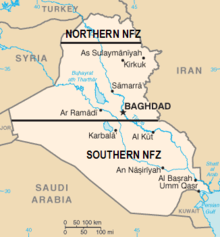Iraq uprising in 1991
The uprising in Iraq in 1991 occurred during and shortly after the Second Gulf War in March 1991. Shiites and Kurds were encouraged to take this step because of Saddam Hussein's military defeat by the Allies. However, because of the ceasefire that had previously come into force, Saddam Hussein had the troops available to brutally suppress the uprising.
In order to protect the insurgents, the Allies established no-fly zones in the north and south of Iraq . Nevertheless, most of the insurgents felt betrayed by the West, as they had expected a further advance of the Alliance and only the ceasefire had given Saddam the opportunity to suppress the uprising.
course
Encouraged by the advance of the US troops and prompted to do so by George HW Bush in a speech given on February 15, the Shiites rose up against Saddam Hussein's rule on March 3, 1991. A few days later, the Kurds in the north finally joined the uprising.
When the rebellious Shiites liberated the city of Najaf in March , the cleric Ayatollah Abu l-Qasim al-Choei appointed a five-person committee to protect the common good. He also tried to make contact with the US troops through his son in order to coordinate the uprising with their advance.
But since the ceasefire between the Allies and Iraq came into effect on April 12, Saddam now had the means to put down both the Kurdish and Shiite uprisings. In the course of the reconquest of the holy cities of Najaf and Karbala , there was severe devastation and looting of the local sanctuaries by the troops of Saddam. Was also Ayatollah al-Choei arrested and after a humiliating demonstration on television under house arrest.
To protect the insurgents, the UN imposed a no-fly zone over northern Iraq in April . It was not until August 25, 1992 that the US government established a no-fly zone over southern Iraq, which is largely inhabited by Shiites. On the one hand, this support came too late, on the other hand, the flight ban only affected aircraft, so that Saddam could still use combat helicopters against the insurgents. It can also be assumed that the air force was not absolutely necessary to suppress the uprising, since Saddam had enough ground troops available.
Numerous people were killed during the conflict. The Shiite insurgents alone suffered between 30,000 and 60,000 fatalities.
background
Bush probably intended with his speech to initiate a coup or a palace revolt against Saddam Hussein. But when the Kurds and Shiites rose up, he feared that Iraq would split along ethnic and sectarian lines. He also saw the threat of Iranian influence over Iraqi politics if the uprising was successful.
For these reasons, the insurgents received no support from the Allied troops. It is even believed that fear of Iranian interference was one of the reasons for the ceasefire between the allies and Iraq.
This attitude of the US government during and after the Second Gulf War was perceived by many insurgents as treason and continues to burden the relationship between the Shiites of Iraq and the USA to this day.
filming
The suppression of the Shiite uprising is also the subject of the satirical war film Three Kings - It's nice to be king with George Clooney and Mark Wahlberg .
See also
Individual evidence
- ^ A b Stephan Bierling: History of the Iraq War: The Overthrow of Saddam and America's Nightmare in the Middle East . CH Beck, Munich 2010, ISBN 978-3-406-60606-9 , p. 22 .
- ↑ Henner Fürtig : Brief history of Iraq: from the foundation in 1921 to the present . CH Beck, Munich 2003, ISBN 978-3-406-49464-2 , p. 130 .
- ↑ a b c Wilfried Buchta: Shiites . Heinrich Hugendubel Verlag, Kreuzlingen; Munich 2004, ISBN 978-3-7205-2491-9 , pp. 101 .
- ↑ Henner Fürtig: Brief history of Iraq: from the foundation in 1921 to the present . CH Beck, Munich 2003, ISBN 978-3-406-49464-2 , p. 131 .
